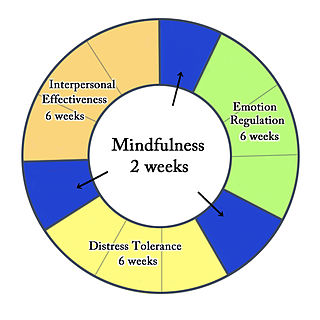Related Research Articles

Cognitive behavioral therapy (CBT) is a psycho-social intervention that aims to reduce symptoms of various mental health conditions, primarily depression and anxiety disorders. Cognitive behavioral therapy is one of the most effective means of treatment for substance abuse and co-occurring mental health disorders. CBT focuses on challenging and changing cognitive distortions and their associated behaviors to improve emotional regulation and develop personal coping strategies that target solving current problems. Though it was originally designed to treat depression, its uses have been expanded to include many issues and the treatment of many mental health conditions, including anxiety, substance use disorders, marital problems, ADHD, and eating disorders. CBT includes a number of cognitive or behavioral psychotherapies that treat defined psychopathologies using evidence-based techniques and strategies.
Paranoia is an instinct or thought process that is believed to be heavily influenced by anxiety, suspicion, or fear, often to the point of delusion and irrationality. Paranoid thinking typically includes persecutory beliefs, or beliefs of conspiracy concerning a perceived threat towards oneself. Paranoia is distinct from phobias, which also involve irrational fear, but usually no blame.

Paradoxical intention (PI) is a psychotherapeutic technique used to treat recursive anxiety by repeatedly rehearsing the anxiety-inducing pattern of thought or behaviour, often with exaggeration and humor. Paradoxical intention has been shown to be effective in treating psychosomatic illnesses such as chronic insomnia, public speaking phobias, etc. by making patients do the opposite of their hyper-intended goal, hindering their ability to perform the activity.

Agoraphobia is a mental and behavioral disorder, specifically an anxiety disorder characterized by symptoms of anxiety in situations where the person perceives their environment to be unsafe with no easy way to escape. These situations can include open spaces, public transit, shopping centers, crowds and queues, or simply being outside their home on their own. Being in these situations may result in a panic attack. Those affected will go to great lengths to avoid these situations. In severe cases, people may become completely unable to leave their homes.

Psychology is an academic and applied discipline involving the scientific study of human mental functions and behavior. Occasionally, in addition or opposition to employing the scientific method, it also relies on symbolic interpretation and critical analysis, although these traditions have tended to be less pronounced than in other social sciences, such as sociology. Psychologists study phenomena such as perception, cognition, emotion, personality, behavior, and interpersonal relationships. Some, especially depth psychologists, also study the unconscious mind.

Dialectical behavior therapy (DBT) is an evidence-based psychotherapy that began with efforts to treat personality disorders and interpersonal conflicts. Evidence suggests that DBT can be useful in treating mood disorders and suicidal ideation as well as for changing behavioral patterns such as self-harm and substance use. DBT evolved into a process in which the therapist and client work with acceptance and change-oriented strategies and ultimately balance and synthesize them—comparable to the philosophical dialectical process of thesis and antithesis, followed by synthesis.
A cognitive distortion is an exaggerated or irrational thought pattern involved in the onset or perpetuation of psychopathological states, such as depression and anxiety.

Cognitive restructuring (CR) is a psychotherapeutic process of learning to identify and dispute irrational or maladaptive thoughts known as cognitive distortions, such as all-or-nothing thinking (splitting), magical thinking, overgeneralization, magnification, and emotional reasoning, which are commonly associated with many mental health disorders. CR employs many strategies, such as Socratic questioning, thought recording, and guided imagery, and is used in many types of therapies, including cognitive behavioral therapy (CBT) and rational emotive behaviour therapy (REBT). A number of studies demonstrate considerable efficacy in using CR-based therapies.
Behaviour therapy or behavioural psychotherapy is a broad term referring to clinical psychotherapy that uses techniques derived from behaviourism and/or cognitive psychology. It looks at specific, learned behaviours and how the environment, or other people's mental states, influences those behaviours, and consists of techniques based on behaviorism's theory of learning: respondent or operant conditioning. Behaviourists who practice these techniques are either behaviour analysts or cognitive-behavioural therapists. They tend to look for treatment outcomes that are objectively measurable. Behaviour therapy does not involve one specific method, but it has a wide range of techniques that can be used to treat a person's psychological problems.
Systematic desensitization, or graduated exposure therapy, is a behavior therapy developed by the psychiatrist Joseph Wolpe. It is used when a phobia or anxiety disorder is maintained by classical conditioning. It shares the same elements of both cognitive-behavioral therapy and applied behavior analysis. When used in applied behavior analysis, it is based on radical behaviorism as it incorporates counterconditioning principles. These include meditation and breathing. From the cognitive psychology perspective, cognitions and feelings precede behavior, so it initially uses cognitive restructuring.
Mysophobia, also known as verminophobia, germophobia, germaphobia, bacillophobia and bacteriophobia, is a pathological fear of contamination and germs. It is classified as a type of specific phobia, meaning it is evaluated and diagnosed based on the experience of high levels of fear and anxiety beyond what is reasonable when exposed to or in anticipation of exposure to stimuli related to the particular concept. William A. Hammond first coined the term in 1879 when describing a case of obsessive–compulsive disorder (OCD) exhibited in repeatedly washing one's hands.
Cognitive therapy (CT) is a type of psychotherapy developed by American psychiatrist Aaron T. Beck. CT is one therapeutic approach within the larger group of cognitive behavioral therapies (CBT) and was first expounded by Beck in the 1960s. Cognitive therapy is based on the cognitive model, which states that thoughts, feelings and behavior are all connected, and that individuals can move toward overcoming difficulties and meeting their goals by identifying and changing unhelpful or inaccurate thinking, problematic behavior, and distressing emotional responses. This involves the individual working with the therapist to develop skills for testing and changing beliefs, identifying distorted thinking, relating to others in different ways, and changing behaviors. A cognitive case conceptualization is developed by the cognitive therapist as a guide to understand the individual's internal reality, select appropriate interventions and identify areas of distress.

In exposure therapy, an exposure hierarchy is developed to help clients confront their feared objects and situations in a manner that is systematic and controlled for the purpose of systematic desensitization. Exposure hierarchies are included in the treatment of a wide range of anxiety disorders.
Exposure therapy is a technique in behavior therapy to treat anxiety disorders. Exposure therapy involves exposing the target patient to the anxiety source or its context without the intention to cause any danger (desensitization). Doing so is thought to help them overcome their anxiety or distress. Procedurally, it is similar to the fear extinction paradigm developed for studying laboratory rodents. Numerous studies have demonstrated its effectiveness in the treatment of disorders such as generalized anxiety disorder, social anxiety disorder, obsessive-compulsive disorder, post-traumatic stress disorder (PTSD), and specific phobias.

Grandiose delusions (GD), also known as delusions of grandeur or expansive delusions, are a subtype of delusion that occur in patients with a wide range of psychiatric disorders, including two-thirds of patients in a manic state of bipolar disorder, half of those with schizophrenia, patients with the grandiose subtype of delusional disorder, frequently in narcissistic personality disorder, and a substantial portion of those with substance abuse disorders. GDs are characterized by fantastical beliefs that one is famous, omnipotent, wealthy, or otherwise very powerful. The delusions are generally fantastic and typically have a religious, science fictional, or supernatural theme. There is a relative lack of research into GD, in contrast to persecutory delusions and auditory hallucinations. Around 10% of healthy people experience grandiose thoughts at some point in their lives but do not meet full criteria for a diagnosis of GD.

A persecutory delusion is a type of delusional condition in which the affected person believes that harm is going to occur to oneself by a persecutor, despite a clear lack of evidence. The person may believe that they are being targeted by an individual or a group of people. Persecution delusions are very diverse in terms of content and vary from the possible, although improbable, to the completely bizarre. The delusion can be found in various disorders, being more usual in psychotic disorders.
PTSD or post-traumatic stress disorder, is a psychiatric disorder characterised by intrusive thoughts and memories, dreams or flashbacks of the event; avoidance of people, places and activities that remind the individual of the event; ongoing negative beliefs about oneself or the world, mood changes and persistent feelings of anger, guilt or fear; alterations in arousal such as increased irritability, angry outbursts, being hypervigilant, or having difficulty with concentration and sleep.
Logic-based therapy (LBT) is a proposed modality of philosophical counseling developed by philosopher Elliot D. Cohen beginning in the mid-1980s. It is a philosophical variant of rational emotive behavior therapy (REBT), which was developed by psychologist Albert Ellis. However, there have been no independent, controlled studies to measure its therapeutic value or advantages over classical REBT.
Cognitive emotional behavioral therapy (CEBT) is an extended version of cognitive behavioral therapy (CBT) aimed at helping individuals to evaluate the basis of their emotional distress and thus reduce the need for associated dysfunctional coping behaviors. This psychotherapeutic intervention draws on a range of models and techniques including dialectical behavior therapy (DBT), mindfulness meditation, acceptance and commitment therapy (ACT), and experiential exercises.
Compassion-focused therapy (CFT) is a system of psychotherapy developed by Paul Gilbert that integrates techniques from cognitive behavioral therapy with concepts from evolutionary psychology, social psychology, developmental psychology, Buddhist psychology, and neuroscience. According to Gilbert, "One of its key concerns is to use compassionate mind training to help people develop and work with experiences of inner warmth, safeness and soothing, via compassion and self-compassion."
References
- ↑ Ryan C. Martin; Eric R. Dahlen (November 2005). "Cognitive emotion regulation in the prediction of depression, anxiety, stress, and anger". Personality and Individual Differences . 39 (November 2005): 1249–1260. doi:10.1016/j.paid.2005.06.004.
- ↑ Steffen Moritz; Lisa Schilling; Katja Wingenfeld; Ulf Köther; Charlotte Wittekind; Kirsten Terfehr; Carsten Spitzer (September 2011). "Persecutory delusions and catastrophic worry in psychosis: Developing the understanding of delusion distress and persistence". Journal of Behavior Therapy and Experimental Psychiatry. 42 (September 2011): 349–354. doi:10.1016/j.jbtep.2011.02.003. PMID 21411041.
- ↑ Reason and Emotion In Psychotherapy. NY: Lyle Stuart, 1962
- ↑ Anxiety Disorders & Phobias. NY: Harper & Row, 1985
- ↑ Theories of Psychotherapy & Counseling: Concepts and Cases. 5th Ed. CA: Brooks/Cole, 2012
- ↑ Cognitive-Behavioral Theories of Counseling: Traditional and Nontraditional. IL: Charles C. Thomas, 2004